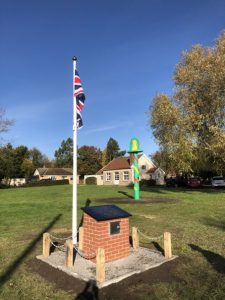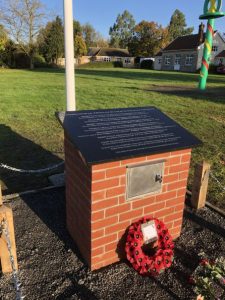More than 100 years after the end of The Great War (or World War 1 as it is now known) the small village of Burston now has a War Memorial.
For many years a Roll of Honour has been hanging in the church of St Mary, which lists the 38 men of the village who went to war, and indicates the eight who made the supreme sacrifice and never returned. The reason why there was no war memorial similar to those found in other villages is lost in the mists of time, but the fact that the famous Strike of pupils from the State school started in 1914, and the Strike School that still stands by the village green today was built in 1917 may have had something to do with it.
In a questionnaire that the Parish Council circulated in 2018 parishioners were asked if they thought that village should have a war memorial, and a lot of responses showed that there was support for this idea. A ‘War Memorial Group’ of three people was established, who investigated possible locations, possible designs, and possible wording for the memorial tablet.
It soon emerged that a position on Church Green would be ideal, as the memorial would be centrally located, and in a visible but not over prominent position. One member of the working party, Nigel Frankland, saw a memorial in the woods near Knettishall Heath, which consisted of a simple brick plinth, with a flint panel inlay, and having a sloping engraved stone on the top at about waist height. Another member of the working party came up with the idea of a cupboard, to be built into the plinth, similar to those found at the War Grave Commission Cemeteries in France and Flanders which could contain a book giving details of those who died, and those who served.
After some discussion it was agreed that the inscription should give the name, rank, regiment, serial number, date of death for each of the Burston men, and details of where each casualty fought, and where they are commemorated by the War Graves Commission. It turned out that only 2 of the 8 had known graves, and the rest were on memorials such the Thiepval Memorial.
An initial appeal led to some residents and businesses promising financial support, and at this stage Cyril Bromley, a retired architect who lives in the village was drawing up plans, and an estimate for an engraved stone had been obtained, but there was still a way to go to reach the target necessary to start building works.
James Easter, the local Councillor on the South Norfolk Council then indicated that his Council had some funding that would be distributed soon, and suggested that if there was an application there would be a good chance that the promises of funding that the group had would be matched by South Norfolk Council.
To make the application more formal the working party joined forces with with the Parish Council, and in September it was confirmed that a substantial grant had been awarded which made the project viable. However, there were only six weeks to Remembrance Day! It was decided that this was just enough time to get the memorial built.
The wording for the stone was finally agreed and Bierton and Woods were commissioned to make it.
 Tommy Bloomfield, a local builder, was asked to build the plinth, and mount the stone, and erect a surrounding fence and a new flagpole. The plinth is built of red brick, with a grey gravel surround. In the front of the plinth is a stainless steel cupboard, made by the apprentices of Waveneys ( known to many as Waveney Pumps Limited) . The rear of the plinth is provided with a flint inlay panel in the form of a cross, and the flints have been taken from local fields, and more of these flints have been incorporated in the centre of the plinth. Probably many of the men named on the memorial worked in the fields where these flints were collected. Work started on Church Green in October, and the stone, a black polished granite slab with silvered engraving, was mounted on the plinth on Friday 8th November, just two days before Remembrance Day.
Tommy Bloomfield, a local builder, was asked to build the plinth, and mount the stone, and erect a surrounding fence and a new flagpole. The plinth is built of red brick, with a grey gravel surround. In the front of the plinth is a stainless steel cupboard, made by the apprentices of Waveneys ( known to many as Waveney Pumps Limited) . The rear of the plinth is provided with a flint inlay panel in the form of a cross, and the flints have been taken from local fields, and more of these flints have been incorporated in the centre of the plinth. Probably many of the men named on the memorial worked in the fields where these flints were collected. Work started on Church Green in October, and the stone, a black polished granite slab with silvered engraving, was mounted on the plinth on Friday 8th November, just two days before Remembrance Day.
At 8 am on Sunday 10th November a large number of residents were by the new memorial to observe a silence, to lay wreaths and flowers, and to hear the names of those who died read out. The ceremony was led by the Reverend David Mills, who held a Communion Service in the church afterwards.
The whole project has been a tremendous team effort. In addition to the funding from South Norfolk Council funding has come from local residents and the Army. Jewsons in Diss have provided building material free of charge, and ForFarmers, who run Burston Mill, provided the oak posts and chains for the surrounding fence.
Peter Rees has undertaken a lot of research into the 8 men who died, and has produced the The War Memorial Book that is now in the cupboard in the memorial. For some of the dead he has found photographs, and details of where they lived, and the battles that they fought in. This book will be expanded as the months go by and more information emerges, and there will also be details of the thirty men who served and then returned after the war. As a ‘work in progress’ if anyone has any more information about anyone named in the book, please can they let us know by emailing the Chair mailto:chair@burstonandshimpling.org.uk
